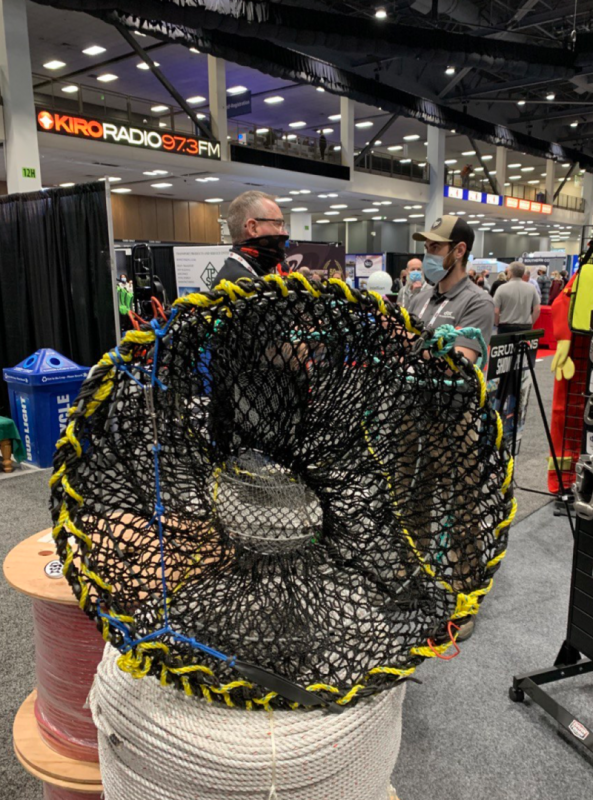With new regulations turning whale avoidance into a top priority in the Gulf of Maine and off California, front-line fishermen sat Friday for a panel discussion at Pacific Marine on what the future may hold for trap fisheries.
NMFS and the state of California are looking to ropeless gear for lobster and crab fisheries as the long-term solution, but such systems are still in development .
California’s Dungeness crab fishermen are yet again cooling their heels in port, awaiting an updated assessment of humpback whale movements and an all-clear from the state Department of Fish and Wildlife to set gear, once the agency judges the danger of entanglements is lowered.
In recent years the usual November crab season opening has been delayed as whales congregate to feed before heading south for their breeding season, said Mike Conroy, executive director of the Pacific Coast Federation of Fishermen’s Associations.
The 2020 season opener was delayed into December – and then complicated when fishermen protested what they considered unfairly low prices for crabs. A price settlement and agreed-on opener didn’t happen until January.
So-called pop-up or ropeless gear, instead of the traditional vertical lines connecting trap lines to buoys, are seen by some agencies and environmental groups as the long-term answer for avoiding accidents with whales and keeping fishermen working.
But many fishermen see pop-up gear as too expensive and problematical. Some West Coast crabbers have been working to test and trial new designs, but political demands to implement ropeless gear inspire mistrust that they could be forced to use a not-ready-for-primetime technology, said Conroy.
Environmental advocates pushed California state lawmakers for a timetable to mandate ropeless gear adoption, said Conroy.
‘ “Hey, California state legislature, NMFS isn’t doing anything so we want you to reintroduce ropeless fishing gear,’” Conroy said of the maneuver that was ultimately defeated by a coalition including both commercial and recreational fishing groups.
“That bill that was introduced last year did more to set back alternative gear types than any other bill,” Conroy added.
Panelists stressed how fishermen want to work with gear developers and researchers in good faith, but are wary of top-down gear solutions.
“We hate to be given the shovel to dig our own grave with,” said Kristan Porter, president of the Maine Lobstermen’s Association, whose members face daunting demands for gear changes to protect endangered northern right whales.
Maine fishermen have worked for years with regulators to reduce entanglement risk, and the last verified case involving Maine gear dates back more than 15 years to a case when the whale was successfully rescued, said Porter. The mortalities that triggered today’s crisis included deaths from entanglements in snow crab gear and ship strikes when more right whales began moving north into Canadian waters, he said.
California Dungeness crabbers have worked to reduce whale risks from existing gear, like keeping excessive slack out of lines, while the humpback population grows.
“We’ve seen a significant increase, and we’ve seen a significant decrease in interaction. Things are moving in the right direction,” said panelist Dick Ogg, captain of the fishing vessel Karen Jeanne and 2019 National Fisherman Highliner who serves with the California Dungeness Crab Working Group.
For developing comprehensive new gear solutions, Ogg said, “the objective would be to get the fishermen to be the majority of the designers and developers.”
Meanwhile, the ‘slinky pot’ appears on track to eliminate fishermen’s losses to whale depredation in the Pacific blackcod fishery. Named for its resemblance to the spring-steel toy, the slinky pot is a lightweight, collapsible design that keeps whales at bay from snacking on fishermen’s catches of blackcod.

Slinky pot suppliers’ display booths attracted much interest on the Pacific Marine Expo show floor, owing to the gear’s word of mouth fame.
Gear designer Alex Stubbs of Fish Tech Inc. estimates there are 20,000 traps at work now. For high-risk, high-cost experimental gear, new development might be spurred by offering fishermen incentives for taking that risk, said Stubbs.
One such approach could be allowing ropeless gear use during times of seasonal whale movements when convention vertical-line gear is not allowed in some areas.
But that raises the prospect of better-financed fishing operations exploiting such an incentive structure to take over traditional fishermen’s grounds, Porter pointed out. In Maine, with 4,000 lobster permit holder who each represent a local small business, that is an integral part of the coastal communities’ character, said Porter.
"fisherman" - Google News
November 20, 2021 at 01:42PM
https://ift.tt/3nAE4gW
Slinky pots and ropeless gear: next angles for whale avoidance - National Fisherman
"fisherman" - Google News
https://ift.tt/35ujXVg
Shoes Man Tutorial
Pos News Update
Meme Update
Korean Entertainment News
Japan News Update
Bagikan Berita Ini














0 Response to "Slinky pots and ropeless gear: next angles for whale avoidance - National Fisherman"
Post a Comment